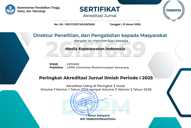Ankle Brakhial Indext (ABI): a tools for detect peripheral arterial disease (PAD)
(1) Universitas Islam Sultan Agung
(2) Universitas Islam Sultan Agung Semarang
(3) Universitas Islam Sultan Agung Semarang
(*) Corresponding Author
Abstract
Peripheral Arterial Disease (PAD) is a common complication among patients with type 2 diabetes mellitus, characterized by atherosclerosis that leads to the narrowing of the arteries in the legs and feet. PAD complications include pain, neuropathy, and potential limb amputation. This study reviews the effectiveness of the Ankle-Brachial Index (ABI) as a diagnostic tool for PAD detection in diabetic patients. A literature review was conducted, sourcing 266 articles from PubMed, Google Scholar, and ScienceDirect databases within the 2019-2024 period; six articles met the inclusion criteria. The analysis indicates that ABI is a sensitive and accurate diagnostic method, particularly for patients with an ABI <0.9 who are at higher risk of cardiovascular complications. PAD risk factors include older age, hypertension, and smoking. ABI also shows high concordance with Doppler Ultrasonography (DUS) for various degrees of arterial stenosis. In conclusion, ABI is a reliable, non-invasive diagnostic tool for early PAD detection in diabetic patients. Routine use of ABI in screening programs may help prevent further complications through early diagnosis and intervention, especially for patients with diabetes mellitus.
Keywords
Full Text:
PDFReferences
Nasution WW, Heryaman H, Martha JW, Ridwan AA. Clinical Manifestation of Peripheral Artery Disease in Type 2 Diabetes Melitus with Ankle Branchial Index Measurement. Journal of Medicine & Health 2019;2:847–55. https://doi.org/10.28932/jmh.v2i3.1224.
Brouwers JJWM, van Doorn LP, Pronk L, van Wissen RC, Putter H, Schepers A, et al. Doppler Ultrasonography Derived Maximal Systolic Acceleration: Value Determination With Artificially Induced Stenosis. Vasc Endovascular Surg 2022;56:472–9. https://doi.org/10.1177/15385744221076269.
Casey S, Lanting S, Oldmeadow C, Chuter V. The reliability of the ankle brachial index: A systematic review. J Foot Ankle Res 2019;12:1–10. https://doi.org/10.1186/s13047-019-0350-1.
Kshatri JS, Satpathy P, Sharma S, Bhoi T, Mishra SP, Sahoo SS. Health research in the state of Odisha, India: A decadal bibliometric analysis (2011 2020). J Family Med Prim Care 2022;6:169–70. https://doi.org/10.4103/jfmpc.jfmpc.
Herraiz-Adillo Á, Cavero-Redondo I, Álvarez-Bueno C, Pozuelo-Carrascosa DP, Solera-Martínez M. The accuracy of toe brachial index and ankle brachial index in the diagnosis of lower limb peripheral arterial disease: A systematic review and meta-analysis. Atherosclerosis 2020;315:81–92. https://doi.org/10.1016/j.atherosclerosis.2020.09.026.
Cervilla Suárez FJ, Muñoz Cobos F, García Ruiz A, Gálvez Alcaraz LF. Alteration of the ankle brachial index, follow-up of patients at risk of peripheral arterial disease, a descriptive longitudinal study. Curr Probl Cardiol 2024;49. https://doi.org/10.1016/j.cpcardiol.2023.102243.
Darwis P, Kler FAA, Karina K, Telaumbanua RS. Evaluasi Spektrum Gelombang USG Doppler dan Kaitannya dengan Ankle Brachial Index (ABI) dan Faktor-Faktor Risiko pada pasien Peripheral Arterial Disease (PAD). Jurnal Llmu Bedah Indonesia 2020;48:68–85. https://doi.org/10.46800/jibi-ikabi.v48i2.66.
Harwood AE, Pugh CJA, Steward CJ, Menzies C, Thake CD, Cullen T. A systematic review of the role of heat therapy for patients with intermittent claudication due to peripheral artery disease. Vascular Medicine (United Kingdom) 2021;26:440–7. https://doi.org/10.1177/1358863X20983475.
Rümenapf G, Morbach S, Schmidt A, Sigl M. Intermittent claudication and asymptomatic peripheral arterial disease. Dtsch Arztebl Int 2020;117:188–93. https://doi.org/10.3238/arztebl.2020.0188.
Ugwu E, Anyanwu A, Olamoyegun M. Ankle brachial index as a surrogate to vascular imaging in evaluation of peripheral artery disease in patients with type 2 diabetes. BMC Cardiovasc Disord 2021;21:6–11. https://doi.org/10.1186/s12872-020-01821-6.
Armas-Padrón AM, Sicilia-Sosvilla M, Rodríguez-Bello S, López-Carmona MD, Ruiz-Esteban P, Hernández D. Abnormal ankle-brachial index, cardiovascular risk factors and healthy lifestyle factors in hypertensive patients: prospective cohort study from a primary care urban population. BMC Primary Care 2022;23:1–13. https://doi.org/10.1186/s12875-022-01837-1.
Watson EL, Patel B, Katsogridakis E, Pepper CJ, Messeder SJ, Saratzis A, et al. Selecting Portable Ankle/Toe Brachial Pressure Index Systems for a Peripheral Arterial Disease Population Screening Programme: a Systematic Review, Clinical Evaluation Exercise, and Consensus Process. European Journal of Vascular and Endovascular Surgery 2022;64:693–702. https://doi.org/10.1016/j.ejvs.2022.08.008.
Johnston AL, Vemulapalli S, Gosch KL, Aronow HD, Abbott JD, Patel MR, et al. Ankle-brachial index in patients with intermittent claudication is a poor indicator of patient-centered and clinician-based evaluations of functional status. J Vasc Surg 2019;69:906–12. https://doi.org/10.1016/j.jvs.2018.07.039.
Doglikuu BID, Abdulai A, Yaseri M, Shakibazadeh E, Djazayery A, Mirzaei K. Association of adherence to diabetics feeding recommendation with glycaemic control and with malnutrition risk among normal weight persons with type 2 diabetes in ghana. Malaysian Journal of Medical Sciences 2021;28:84–99. https://doi.org/10.21315/mjms2021.28.2.8.
Alagha M, Aherne TM, Hassanin A, Zafar AS, Joyce DP, Mahmood W, et al. Diagnostic Performance of Ankle-Brachial Pressure Index in Lower Extremity Arterial Disease. The Surgery Journal 2021;07:e132–7. https://doi.org/10.1055/s-0041-1731444.
M.McDermoott M. Imaging in pheripheral arterial disease. USA: Springer International Publishing; 2020. https://doi.org/http://doi.org/10.1007/978-3-030-24596-2_2.
Medicine S. ankle-brachial-index @ stanfordmedicine25.stanford.edu 2024.
Singhania P, Das TC, Bose C, Mondal A, Bhattacharjee R, Singh A, et al. Toe brachial index and not ankle brachial index is appropriate in initial evaluation of peripheral arterial disease in type 2 diabetes. Diabetol Metab Syndr 2024;16:1–10. https://doi.org/10.1186/s13098-024-01291-2.
Li L, Zhang J, Wang L, Zhao Z, Xia Y. Association of Body Fluid Volumes and Body Fat Distribution with Abnormal Ankle-Brachial Index. Artery Res 2022;28:91–9. https://doi.org/10.1007/s44200-022-00018-w.
Felício JS, de Melo FTC, Vieira GM, de Aquino VT, de Souza Parente F, da Silva WM, et al. Peripheral arterial disease progression and ankle brachial index: a cohort study with newly diagnosed patients with type 2 diabetes. BMC Cardiovasc Disord 2022;22:1–10. https://doi.org/10.1186/s12872-022-02722-6.
Sartore G, Caprino R, Ragazzi E, Bianchi L, Lapolla A, Piarulli F. The ankle-brachial index for assessing the prevalence of peripheral artery disease and cardiovascular risk in patients with type 2 diabetes mellitus. Nutrition, Metabolism and Cardiovascular Diseases 2023;33:560–7. https://doi.org/10.1016/j.numecd.2022.11.019.
Hemingway J, Adjei E, Desikan S, Gross J, Tran N, Singh N, et al. Re-evaluating the safety and effectiveness of the 0.9 ankle-brachial index threshold in penetrating lower extremity trauma. J Vasc Surg 2020;72:1305-1311.e1. https://doi.org/10.1016/j.jvs.2020.01.051.
Mphasha MH, Mothiba TM, Skaal L. Family support in the management of diabetes patients’ perspectives from Limpopo province in South Africa. BMC Public Health 2022;22:1–8. https://doi.org/10.1186/s12889-022-14903-1.
Fallace P, Aiese P, Bianco E, Bolognini I, Costa MP, Esposito R, et al. Peer Education strategies for promoting prevention of doping in different populations. Ann Ig 2019;31:556–75. https://doi.org/10.7416/ai.2019.2316.
Mphasha M, Mothiba T, Skaal L. Assessment of diabetes dietary knowledge and its impact on intake of patients in Senwabarwana, Limpopo, South Africa. Journal of Endocrinology, Metabolism and Diabetes of South Africa 2021;26:89–95. https://doi.org/10.1080/16089677.2021.1927584.
Prasad A, Choh AC, Gonzalez ND, Garcia M, Lee M, Watt G, et al. A high burden of diabetes and ankle brachial index abnormalities exists in Mexican Americans in South Texas. Prev Med Rep 2024;38:102604. https://doi.org/10.1016/j.pmedr.2024.102604.
Chuter V, Schaper N, Hinchliffe R, Mills J, Azuma N, Behrendt CA, et al. Performance of non-invasive bedside vascular testing in the prediction of wound healing or amputation among people with foot ulcers in diabetes: A systematic review. Diabetes Metab Res Rev 2024;40:1–16. https://doi.org/10.1002/dmrr.3701.
Asir TR, Antono D, Yunir E, Shatri H. Hubungan Derajat Neuropati Perifer Diabetik dengan Ankle Brachial Index, Toe Brachial Index, dan Transcutaneous Partial Oxygen Pressure pada Pasien Diabetes Melitus Tipe 2. Jurnal Penyakit Dalam Indonesia 2020;7:135. https://doi.org/10.7454/jpdi.v7i3.390.
Pizzey FK, Smith EC, Ruediger SL, Keating SE, Askew CD, Coombes JS, et al. The effect of heat therapy on blood pressure and peripheral vascular function: A systematic review and meta-analysis. Exp Physiol 2021;106:1317–34. https://doi.org/10.1113/EP089424.
Article Metrics
Abstract view : 242 timesPDF - 21 times
DOI: https://doi.org/10.26714/mki.7.2.2024.164-174
Refbacks
- There are currently no refbacks.
Copyright (c) 2024 Riska Wahyuni, Nopi Nur Khasanah, Ahmad Ikhlasul Amal

This work is licensed under a Creative Commons Attribution 4.0 International License.
This journal is indexed by:
Kedungmundu Raya No. 18 Semarang NRC Building Universitas Muhammadiyah Semarang
Phone: 02476740287
Fax: 02476740287
Email: mki@unimus.ac.id





















